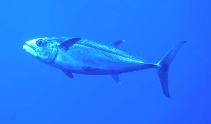| Family: |
Scombridae (Mackerels, tunas, bonitos), subfamily: Scombrinae |
| Max. size: |
247.98 cm FL (male/unsexed); max.weight: 131 kg |
| Environment: |
reef-associated; marine; depth range 0 - 250 m, oceanodromous |
| Distribution: |
Indo-Pacific: Red Sea and East Africa to French Polynesia, north to Japan, south to Australia. |
| Diagnosis: |
Dorsal spines (total): 13-15; Dorsal soft rays (total): 12-14; Anal spines: 0-0; Anal soft rays: 12-13; Vertebrae: 38-38. This species is distinguished by the following characters: body elongate and moderately compressed; mouth fairly large, upper jaw reaching to middle of eye; 14 to 31 large, conical teeth on upper jaw, 10 to 24 on lower jaw; 2 patches of villiform teeth on upper surface of tongue; total gill rakers on first gill arch 11-14; D1 XIII-XV, its border almost straight, the second followed by 6-7 finlets, dorsal fins close together; anal fin followed by 6 finlets; pectoral fins with 25-28 rays; interpelvic process large and single; lateral line strongly undulating; body naked posterior to corselet except for lateral line, dorsal-fin base, and caudal keel; caudal peduncle slender, with a well-developed lateral keel between 2 smaller keels on each side. Colour of back and upper sides brilliant blue-black, lower sides and belly silvery; no lines, spots or other markings on body; anterior tip of first dorsal fin dark; other fins greyish (Ref. 9684). |
| Biology: |
An offshore species found mainly around coral reefs. Generally solitary or occur in small schools of six or less. Preys on small schooling fishes such as Decapterus, Caesio, Nasio, Cirrhilabrus, Pterocaesio and squids. Caught mainly by pole-and-line. Marketed canned and frozen (Ref. 9684, 48637). Adults may be ciguatoxic (Ref. 37816). Minimum depth reported taken from Ref. 128797. |
| IUCN Red List Status: |
Least Concern (LC); Date assessed: 01 March 2022 Ref. (130435)
|
| Threat to humans: |
reports of ciguatera poisoning |
| Country info: |
Regularly caught in small numbers during certain seasons. Also Ref. 53416, 121724. |
Source and more info: www.fishbase.org. For personal, classroom, and other internal use only. Not for publication.

